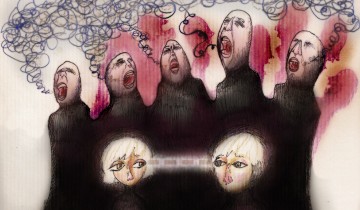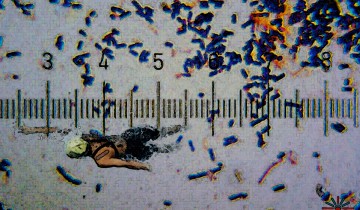By Roberta Attanasio, Forever Leaders Editor
From “The only definition of a leader is someone who has followers” (Peter Drucker) to “Leaders will be those who empower others” (Bill Gates), there are plenty of convergent and divergent thoughts, ideas, and beliefs that have been used to answer the question: “What makes a leader?”
Indeed, “What makes a leader?” is the title of an influential article published in 1998 by the Harvard Business Review. In the article, Daniel Goleman—author of the book “Emotional Intelligence“—explains how truly effective leaders are distinguished by a high degree of emotional intelligence, which includes self-awareness, self-regulation, motivation, empathy, and social skill. Since then, emotional intelligence has been gaining increasing consideration in popular culture, the academic community, and the business world. However, there is still ample debate on what makes a leader.

Image credit: Emil Indricău, CC BY 2.0
But, what makes a creative leader? According to a new study, the key quality of a creative leader is creative self-efficacy, defined as ‘‘a self-belief that one has the ability to produce creative outcomes.” In other words, teams produce more creative outcomes when their leaders have greater confidence in their own creativity. The study (I can do it, so can you: The role of leader creative self-efficacy in facilitating follower creativity) analyzed a sample of 544 employees nested under 106 supervisors at a large U.S. information technology company. The study results suggest that leader creative self-efficacy (a leader attribute) promotes leader encouragement of creativity (a leader behavior), which will in turn motivate employees to engage in creative processes (a follower behavior) and, ultimately, improve their creativity (a follower outcome).
Thus, the study results highlighted that a leader’s creativity and confidence is contagious. Dina Krasikova, one of the study authors, said in a press release: “A factor in this is the power of positive thinking, Leaders can imbue their subordinates with confidence and creativity just by setting an example themselves.”
Krasikova also stressed the importance of high-quality interpersonal relationships between leaders and subordinates, with an emphasis on trust, loyalty and mutual professional respect. “When a confident, creative leader also has good relationship with subordinates, it has even a stronger impact on subordinates’ creativity,” she said. “Creativity flourishes in supportive environments where leaders and subordinates have good interpersonal relationships. In such environments, subordinates will go an extra mile for a leader without expecting anything in return because they have a good relationship. They can depend on each other, because they trust each other.”
On the basis of their results, the study authors suggest that organizations that value employee creativity should develop leadership programs centered on fostering leaders’ confidence in producing creativity, thus using valuable resources to improve leader creative self-efficacy which, in turn, will be beneficial to both leader and follower creativity. In addition, the study authors suggest that organizations launch intervention programs that strengthen relationships between leaders and followers—as for example one-on-one mentorship/coaching and social events, which can help connect employees with leaders. The suggested intervention programs should be based on frequent social interactions that facilitate quality conversations, mutual understanding, and meaningful connections between leaders and followers.
Creativity leads to innovation within organizations and, therefore, to increased success potential. Creativity expert Sir Ken Robinson makes the case for creativity as the crucial 21st century skill we’ll need to solve today’s pressing problems. A 2010 survey of more than 1,500 Chief Executive Officers (CEOs) from 60 countries and 33 industries worldwide found that CEOs believe that effectively navigating an increasing complex world will require creativity.
Successful organizations can now design research-based intervention programs that foster creative leadership.
Copyright © 2016-2018 Forever Leaders.




Creative self-efficacy is an important trait that both leaders and followers alike should be encouraged to foster. The study implies that having a leader with this trait is more important in facilitating the innovative flow within a working environment. Although I agree that having a creative leader that can encourage and inspire others to exceed their potential is vital, however, I also believe that a leader should recognize those that exude creative self-efficacy and urge those people to display their talents and inspire others around them. The study was done within only one company. It would be interesting to see what the outcome would be if the study were done in a company that seeks to hire independent people who already possess creative flare and innovative insight. Would the focus still be on the leader’s confidence in their own ability to produce creative outcomes? I do wholeheartedly agree that companies take the initiative to develop intervention programs. Meaningful relationships between leaders and those they need to lead are key to making any company run smoothly. It can eliminate conflict and strengthen the team in a way that makes the company productive and solid. Creativity can be displayed and utilized in finding solutions for conflicts, bringing understanding between different personalities, ideologies, opinions, and cultures, and making the interactions between leaders and employees more positive, productive and meaningful.
In my opinion as we grow older we slowly start to lose our sense of creativity. That is not to say that we begin to lose our capacity to be creative, but we have institutions that encourage us to follow rules and regulations than create out own ideas. In college when I am taking courses, I find that most assignments that I am given have to be followed by a certain criteria. We are given rubrics that tell us exactly what needs to be on our “project” or “assignment.” These rubrics keep us from testing our full potential. That is why this semester I grew to love my Organic Chemistry lab professor. When it was time to write a lab report he refused to give us a rubric and encouraged us to go beyond the traditional definition of a lab report. Though many students chose to write the usual academic and rote lab report, I made a 10 page journal that parodies The Origin Of Species by Charles Darwin. This version of my lab report I admit took a lot more time than it would have taken me if I wrote a regular report, but I thoroughly enjoyed my time writing it. It also allowed me to think outside of the box without worrying that it would hurt my grade. I ended the class with an A and a huge smile from my professor. I wish there were more opportunities like this for undergraduates. We are too often told to follow instructions rather than give us the power to have creative output.
I completely agree that as the older we get the more the institutions that we are a part of stifle our creativity with rules, regulations, and protocols. As children in elementary and middle school we are encouraged to use our imagination and complete assignments in the most creative way we can. However, as we become young adults in high school and college we are completely discouraged to even think about going against the status quo academically or otherwise. As young adults we are faced with the paradox of being told to stand out amongst our peers but to also follow all the rules and guidelines provided to us, just like everyone else. As a result, many students find it very difficult to handle assignments in creative ways when they are presented with an opportunity to do so. For example, when my Molecular Cell Biology professor gave the class a project for which we had to create a social media poster for a specific type of cell, I found it much more challenging than it actually was because the guidelines were very general and the project required a lot of creativity. This was not due to my lacking creativity (I actually paint and produce music as a hobby), but the difficulty I had with the project was due to the fact that it had been such a long time since I’d been allowed to approach an assignment creatively that I’d nearly forgot how to. The fact that the situation I found myself in is the same situation that many other find themselves in, both academically and professionally, is very alarming. Institutions do not realize the large disservice they are doing to themselves and their substituents by implementing such rigid protocols for long periods of time during the late-academic and early-professional careers of individuals in an increasingly complex world that requires creative minds to lead the effort in solving today’s problems.
I find this article very interesting, as I always assumed creativity is only used in jobs specifically related to artistic capabilities (writing, ad design, home improvement and such). However, after reading this article, everything makes much more sense. My boss is a very creative person and is always willing to be flexible and find other creative solutions to problems we face at our workplace. It not only causes us to respect him more, but also encourages us to be creative ourselves without his direction. He teaches us to use our imaginations when faced with an obstacle rather than just automatically turning to him for help (which would require no use of imagination or creative thinking). This stimulates us to come up with ideas outside of the box that we wouldn’t normally consider, thus allowing us to gain respect from him as well.
I used this type of thinking at the Commencement Ceremony last semester. My old boss was nowhere to be found and was not doing her job properly, so I was unable to have direction or get in contact with her. I needed to make a physical barrier fast for the graduates, and could not find the poles that were supposed to be used as the barriers. Not only was I confused and worried, but I was also leading a large team of volunteers and didn’t want them to see me panicked. So, I came up with the fastest and most creative solution I could in the amount of time I was given: I used my volunteers as a barrier. I told them to line up side by side with a foot or two between each of them, and instructed them to not let any students go past them. Not only did this work very well in my favor, but my boss’s boss noticed me (finally) and said how impressed she was with how I handled the situation. Not only did I gain respect from the volunteers as a leader, but I also gained respect from the higher boss as an employee. My creativity got her to notice my presence and also keep everything in order.
My organic chemistry professor once told us to never grow up and lose our sense of imagination, because it is the imaginative processes that produce the most amazing solutions. Imagination allows you to think outside of the box, integrate aspects that aren’t so ‘cookie cutter’ and may not be obviously correlated to one another, and to apply them to any task that comes your way. I think of it in the terms of environmental protection. We are faced with a number of environmental issues that need creative and effective solutions, and fast. New ways to deal with hard to recycle materials, clean up polluted waters, and stop/reverse the affects of global warming. Creativity is useful, might I say vital, for success in any field of study or career. The idea that creativity in a leadership/follower relationship is ‘infectious’ is absolutely true! If you surround yourself with the mundane, you yourself begin to feel mundane. But if you surround yourself with those that challenge you think in a different way, from a different perspective, outside of the box, you may discover things you never thought possible.
I love this advice from your professor. A lot of people are taught to just fit in and just get work done. I think a majority of people feel accepted when they fit in with the norm. I think it takes a strong person to go against the norm and do something different. I agree with you about how being creative is useful. There are so many problems thats need to be solved, and previous attempts have not been successful. Being innovative and thinking outside of the box will help create solutions to these problems. Also, being a creative leader will help inspire others to follow in your footsteps and be different. I think different can lead to the world changing for the better.
Wonderful advice from your professor! It is true that as we get older, we become more set in our ways and lose the ability to navigate our environment with the level of creativity that children have. Creativity is essential to innovation, and creative leaders need to reach out to those of us who have lost touch with our childlike ability to fearlessly take on any obstacle. If people can tap back into this fearlessness, and gain confidence in our own abilities, we will begin to see solutions to many of the worlds problems.
I really liked learning about creative self efficacy. As an aspiring entrepreneur, creativity is always something that challenges me. My biggest challenge is not creativity itself, but the new influx of creativity in technology. It can overwhelm me sometime, and is a challenge I know I will be faced with in the near future. I desire to be creative and innovative like the man who created the Uber app. I want what I do to really have a positive influence in people’s lives, and I desire to make a profit. Both are equally important to me. I believe a good attribute to have is to be someone who embraces a creative and dynamic environment. That is an attribute of a leader. I have experienced being around a leader who engaged in creative activities and saw how it inspired me. It challenged me and made me consider the things that I am capable of. All of these new and innovative ideas that bring success to people really challenge me, and I love and appreciate the challenge.
Jade, I completely understand your dilemma of being overwhelmed by technology. I myself am not a creative person but I commend those who are. The ability to create businesses and products out of thoughts and dreams astounds me and I am eager to see what you produce! Being creative in a dynamic environment is essential for any leader in today’s society. It is important for employees to value creativity and development of leadership programs centered on fostering leaders’ confidence in producing creativity would be a valuable asset to the workplace. Best success to you in your entrepreneurial endeavors!
Society promotes leadership, and its qualities are highly regarded when applying to colleges or jobs today. This entire world is founded upon leaders, and whether they be prime ministers, presidents, or kings and queens, citizens look to them for guidance and trust, trust that these leaders will promote the well-being of their people.
Society seeks to improve and innovate, and having a creative leader in effect boosts creativity in his/her followers. Creativity in leaders also improves the relationship between a leader and the followers by gaining their trust; one of the fundamental qualities of a leader is all about having the trust of people that allows them to follow the person no matter what decision he/she makes. That is why a leader having the fidelity and respect of the followers means such a high compliment. These are also what I aim for as a possible leader one day. A creative leader who promotes change and does not stick to mundane routine, hence defining the word creativity, allows the followers to also follow his lead and be more open, to take the initiative, and sometimes to follow their own instincts. Being a follower all my life, having be a “leader” in order to stand out from the rest of my peers made me feel uncomfortable. Yet, after being nominated as a leader this year, I realized that I had to step up from my comfort zone and set up an example for the potential followers to look up to, but not limited to, as their guidepost so that someday they would too become leaders.
Dasom, you make a wonderful point! While the emphasis of this post was on creativity, I believe that a certain level of attention should be paid to the relationships among leaders and their followers. When there is open communication and a certain level of respect and trust among superiors and their subordinates, there is far more room for creative thinking to take place. By having a mutual respect for one another, both bosses and their employees can make a more productive and inviting workplace. As quoted by Krasikova in this post, “…subordinates will go an extra mile for a leader without expecting anything in return because they have a good relationship.” Having personally encountered both good and less than favorable relationships with those in a leadership position, I can personally attest to this fact; when someone in a position of power makes the effort to listen and form a good relationship with me in a professional setting, it absolutely produces feelings of willingness to do extra work and even take more risks (e.g. speaking up, voicing new ideas/troubleshooting methods, etc.)! If more people felt comfortable releasing their creative ideas in the workplace, who knows where the future could take us! After all, some of the best ideas stem from thinking outside of the box.